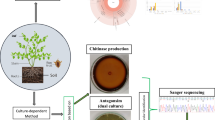Abstract
Ectomycorrhizal syntheses between Picea abies and the fungal associates Scleroderma citrinum, Boletus luridus, and Tricholoma vaccinum were carried out using Melin's Erlenmeyer flask technique. The symbioses of S. citrinum were characterized by a mantle composed of an outer prosenchymatous and an inner synenchymatous layer. The mantles of B. luridus and T. vaccinum were solely prosenchymatous. Rhizomorphs were produced in all treatments, but only in association with S. citrinum were they differentiated with additional, enlarged hyphae. All synthesized ectomycorrhizae were white or whitish to light orange and greyishorange. On large-scale root sampling in two differing Picea abies forests in Switzerland, nine out of a total of 22 morphological types of ectomycorrhizae were white or yellow in colour and were, therefore, comparable with the synthesized ectomycorrhizae. These nine natural types generally had distinct mantle features (irregular synenchyma, gelatinous matrix, cystides, thick-walled hyphae), but mostly lacked clamp connections. Synthesized ectomycorrhizae, on the other hand, lacked distinct mantle characteristics and always had clamp connections. Natural and synthesized white or yellow ectomycorrhizae did not coincide morphologically and thus identification of the fungal partners of natural symbioses by means of in vitro-synthesis with potential ectomycorrhizal fungi was not possible in the present study.
Similar content being viewed by others
References
Agerer R (1987a) Colour atlas of ectomycorrhizae. Einhorn, Schwäbisch Gmünd
Agerer R (1987b) Studies on ectomycorrhizae. IX. Mycorrhizae formed by Tricholoma sulfureum and T. vaccinum on spruce. Mycotaxon 28:327–360
Breitenbach J, Kränzlin F (1986) Pilze der Schweiz. II. Aphyllophorales. Mykologia, Luzern
Breitenbach J, Kränzlin F (1991) Pilze der Schweiz. III. Röhrlinge und Blätterpilze. Mykologia, Luzern
Brunner I (1991) Comparative studies on ectomycorrhizae synthesized with various in vitro techniques using Picea abies and two Hebeloma species. Trees 5:90–94
Brunner I, Scheidegger C (1992) Ontogeny of synthesized Picea abies (L.) Karst. Hebeloma crustuliniforme (Bull. ex. St. Amans) Quél, ectomycorrhizas. New Phytol 120:359–369
Brunner I, Amiet R, Schneider B (1991) Characterization of naturally grown and in vitro synthesized ectomycorrhizae of Hebeloma crustuliniforme and Picea abies. Mycol Res 95:1407–1413
Clark G (1981) Staining procedures. Williams & Wilkins, Baltimore
Dahlberg A, Wallander H (1990) Ectomycorrhizal communities in coniferous forest soil reflected by isoenzymatic analyses of mycorrhizae and sporocarps (abstract). In: Allen MF, Williams SE (eds) Eighth North American Conference on Mycorrhizae. University of Wyoming, Jackson, WY, p 65
Egli S (1991) Morphologische Untersuchungen der Mykorrhizaverhältnisse an Fichten auf den Beobachtungsflächen Lägern und Davos. In: Stark M (ed) Lufthaushalt, Luftverschmutzung und Waldschäden in der Schweiz. V. Luftschadstoffe und Wald. Verlag der Fachvereine, Zürich, pp 187–193
Favre J (1960) Catalogue descriptif des champignons supérieurs de la zone subalpine du parc national suisse. Ergeb Wiss Untersuch Schweiz Nationalparkes 6:323–610
Fries N (1942) Einspormycelien einiger Basidiomyceten als Mykorrhizabildner von Kiefer und Fichte. Sven Bot Tidskr 36:151–156
Gardes M, White TJ, Fortin JA, Bruns TD, Taylor JW (1991) Identification of indigenous and introduced symbiotic fungi in ectomycorrhizae by amplification of nuclear and mitochondrial DNA. Can J Bot 69:180–190
Godbout C, Fortin JA (1983) Morphological features of synthesized ectomycorrhizae of Alnus crispa and A. rugosa. New Phytol 94:249–262
Godbout C, Fortin JA (1985) Synthesized ectomycorrhizae of aspen: fungal genus level of structural characterization. Can J Bot 63:252–262
Gronbach E (1988) Charakterisierung und Identifizierung von Ektomykorrhizen in einem Fichtenbestand mit Untersuchungen zur Merkmalsvariabilität in sauer beregneten Flächen. Bibl Mycol 125:1–216
Horak E (1963) Pilzökologische Untersuchungen in der subalpinen Stufe (Piceetum subalpinum und Rhodoreto-Vaccinietum) der rätischen Alpen. Mitt Schweiz Anst Forstl Versuchswes 31:1–112
Horak E (1985) Die Pilzflora (Macromyceten) und ihre Ökologie in fünf Pflanzengesellschaften der montan-subalpinen Stufe des Unterengadins (Schweiz). Ergeb Wiss Untersuch Schweiz Nationalparkes 12:337–476
Ingleby K, Mason PA, Last FT, Fleming LV (1990) Identification of ectomycorrhizas. Her Majesty's Stationary Office, London
Kornerup A, Wanscher JH (1978) Methuen handbook of colour. Methuen, London
Kottke I (1986) Charakterisierung und Identifizierung von Mykorrhizen. In: Einsele G (ed) Das landschaftsökologische Forschungsprojekt Naturpark Schönbuch (Forschungsbericht). Deutsche Forschungsgemeinschaft, Weinheim, pp 463–485
Marx DH, Bryan WC (1975) Growth and ectomycorrhizal development of loblolly pine seedlings in fumigated soil infested with the fungal symbiont Pisolithus tinctorius. For Sci 21:245–254
Melin E (1922) Untersuchungen über die Larix-Mykorrhiza. I. Synthese der Mykorrhiza in Reinkultur. Sven Bot Tidskr 16:161–196
Modess O (1941) Zur Kenntnis der Mykorrhizabildner von Kiefer und Fichte. Symb Bot Ups 5:1–146
Molina R, Tappe JM (1982) Patterns of ectomycorrhizal host specificity and potential among Pacific northwest conifers and fungi. For Sci 28:423–458
Richter DL, Bruhn JN (1986) Pure culture synthesis of Pinus resinosa ectomycorrhizae with Scleroderma aurantium. Mycologia 78:139–142
Richter DL, Bruhn JN (1990) Scleroderma citrinum (Gastromycetes, Sclerodermatales) and Larix decidua form ectomycorrhiza in pure culture. Nova Hedwigia Z Kryptogamenkd 50:355–360
Rose RW Jr, Van Dyke CG, Davey CB (1981) Scanning electron microscopy of three types of ectomycorrhizae formed on Eucalyptus nova-anglica in the southeastern United States. Can J Bot 59:683–688
Sen R (1990) Isozymic identification of individual ectomycorrhizas synthesized between Scots pine (Pinus sylvestris L.) and isolates of two species of Suillus. New Phytol 114:617–626
Trappe JM (1962) Fungus associates of ectotrophic mycorrhizae. Bot Rev 28:538–606
Uhl M (1988) Studies on ectomycorrhizae. XVI. Ectomycorrhizae formed by Tricholoma flavobrunneum and Betula pendula and Tricholoma auratum and Pinus silvestris. Mycotaxon 33:1–21
Voiry H (1981) Classification morphologique des ectomycorrhizes du chêne et du hêtre dans le nord-est de la France. Eur J For Pathol 11:284–299
Zak B (1973) Classification of ectomycorrhizae. In: Marks GC, Kozlowski TT (eds) Ectomycorrhizae. Academic Press, New York, pp 43–78
Author information
Authors and Affiliations
Rights and permissions
About this article
Cite this article
Brunner, I., Amiet, R., Zollinger, M. et al. Ectomycorrhizal syntheses with Picea abies and three fungal species: a case study on the use of an in vitro technique to identify naturally occurring ectomycorrhizae. Mycorrhiza 2, 89–96 (1992). https://doi.org/10.1007/BF00203255
Issue Date:
DOI: https://doi.org/10.1007/BF00203255




